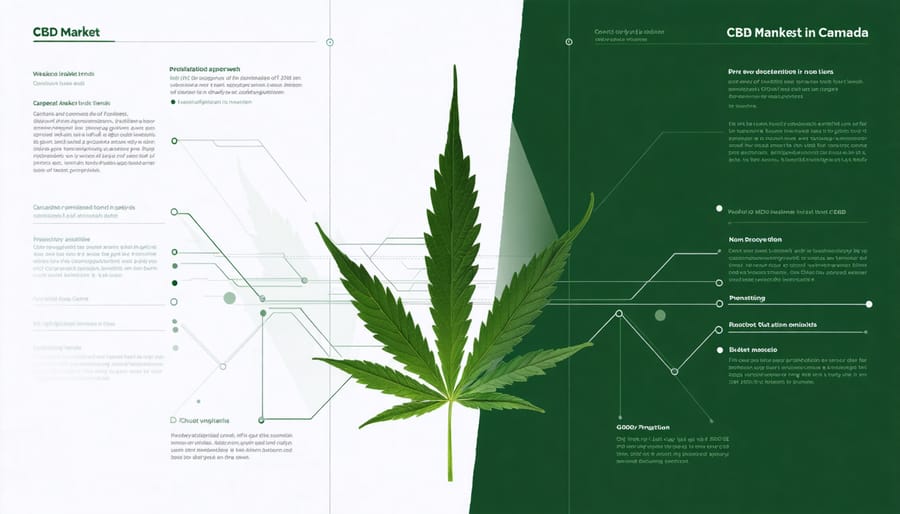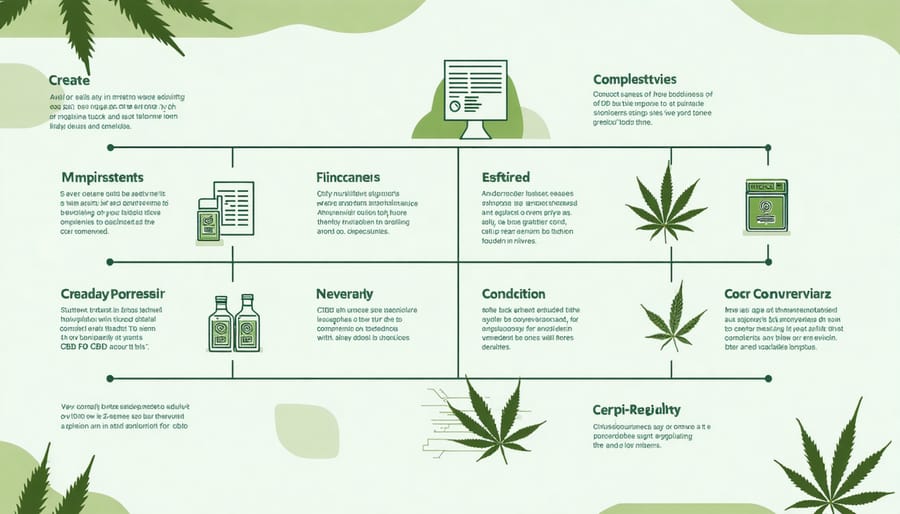Canada’s CBD market presents unprecedented opportunities for businesses, with projected growth reaching $5.2 billion by 2026. Check out the top-rated CBD oil brand in Canada to understand quality benchmarks driving market success. Recent regulatory changes, coupled with increasing consumer awareness and demand for wellness products, have created a fertile environment for business growth across multiple channels – from retail to e-commerce platforms.
Market research indicates that 78% of Canadian consumers now recognize CBD as a legitimate wellness solution, with 45% expressing interest in trying CBD products within the next year. This surge in consumer confidence, backed by stringent quality controls and transparent manufacturing processes, positions Canadian businesses uniquely in the global CBD marketplace.
For entrepreneurs and established businesses alike, understanding these market dynamics is crucial for capitalizing on emerging opportunities while navigating regulatory requirements effectively. This comprehensive analysis will guide you through current market trends, consumer behaviors, and strategic positioning techniques essential for success in Canada’s rapidly evolving CBD industry.
Current Market Size and Growth Projections

Key Market Segments
The Canadian CBD market is diversifying rapidly, with several key product categories emerging as consumer favorites. Oils and tinctures continue to dominate, representing approximately 35% of the market share, thanks to their versatility and ease of use. Topicals, including creams and balms, follow at 25%, showing strong growth particularly among wellness-focused consumers.
Edibles and beverages are gaining significant traction, currently accounting for 20% of the market. Industry leader CannaLife reports a 150% increase in CBD-infused beverage sales over the past year. Pet products represent a fast-growing segment at 10%, with Canadian pet owners increasingly seeking natural alternatives for their companions.
Capsules and softgels maintain a steady 8% market share, appealing to consumers seeking precise dosing and convenience. The remaining 2% comprises innovative products like CBD-infused cosmetics and personal care items. According to market analyst Sarah Thompson of Cannabis Industry Insights, “Product diversification is key to capturing different consumer demographics, with each segment showing unique growth patterns and consumer preferences.”
This segmentation offers multiple entry points for businesses, allowing for targeted market approaches based on specific consumer needs and preferences.
Regional Market Distribution
The CBD market in Canada shows distinct regional variations, with Ontario and British Columbia leading consumption and retail presence. Ontario commands approximately 38% of the national CBD market share, driven by its large population centers and progressive retail policies. British Columbia follows at 24%, benefiting from its established cannabis culture and early adoption of CBD products.
Quebec, despite its size, represents 15% of the market, with growth somewhat tempered by stricter provincial regulations. Alberta has emerged as a surprising contender, capturing 12% of the market share thanks to its business-friendly licensing approach and rapid retail expansion.
The Atlantic provinces collectively account for 7% of the market, with Nova Scotia showing particularly promising growth rates. Manitoba and Saskatchewan together represent 4%, while the territories make up the remaining market share.
Urban centers across these regions demonstrate stronger CBD product adoption, with Toronto, Vancouver, and Montreal serving as key market hubs. Rural areas show increasing potential, particularly in agricultural regions where hemp cultivation has created strong local supply chains and community support for CBD products.
Consumer Behavior and Preferences
Demographics and Buying Patterns
Recent consumer behavior analysis reveals distinct patterns in Canada’s CBD market. The primary consumer segment consists of adults aged 35-54, representing approximately 45% of CBD purchases. This demographic typically prioritizes quality and authenticity, with 72% willing to pay premium prices for lab-tested products.
Urban professionals in major metropolitan areas like Toronto, Vancouver, and Montreal show the highest adoption rates, with wellness-conscious millennials driving significant market growth. These consumers predominantly purchase CBD products for stress relief, sleep improvement, and pain management.
Online sales channels account for 60% of CBD purchases, with consumers spending an average of $75-100 per month on CBD products. Subscription-based models are gaining traction, particularly among regular users who value convenience and consistency.
Research indicates that Canadian consumers strongly prefer domestic brands, with 65% citing local production as a key purchasing factor. First-time buyers typically start with lower-concentration products before graduating to stronger options, showing a clear progression in purchasing patterns.
Educational level and income significantly influence buying decisions, with university-educated professionals showing higher adoption rates. Female consumers lead slightly in market share at 54%, though male consumers typically make larger individual purchases.
Product Preferences
Canadian consumers consistently demonstrate strong preferences for specific CBD product formats, with oils and tinctures leading the market at 45% of total sales. These products are favored for their precise dosing capabilities and versatility in consumption methods. Edibles, particularly gummies and beverages, follow closely behind, capturing 30% of market share and showing remarkable growth potential.
Topical products, including creams, lotions, and balms, represent 15% of the market and are gaining popularity among wellness-focused consumers. As noted by Sarah Chen, founder of Vancouver-based CBD wellness brand Pure North, “We’ve seen a 200% increase in demand for topical products over the past year, particularly among consumers aged 45 and above.”
Emerging trends indicate growing interest in specialized formulations, such as sleep-specific products and wellness supplements combining CBD with other natural ingredients. Premium pet products are also experiencing significant growth, with market research showing a 150% year-over-year increase in this category.
Innovation in delivery methods continues to shape consumer preferences, with water-soluble CBD products and rapid-absorption technologies gaining traction. Industry experts predict that nano-emulsion technology will drive the next wave of product development, offering improved bioavailability and faster onset times. Businesses focusing on product quality and innovative delivery systems are best positioned to capture market share in this evolving landscape.


Regulatory Framework and Compliance
Operating in Canada’s CBD market requires strict adherence to CBD regulatory requirements established under the Cannabis Act and its regulations. Businesses must obtain the appropriate licenses from Health Canada before engaging in any CBD-related activities, including cultivation, processing, or retail sales.
For manufacturers and processors, compliance includes maintaining Good Production Practices (GPP), implementing quality control measures, and ensuring proper product testing and verification. All CBD products must undergo laboratory testing for potency, contaminants, and pesticides before reaching the market.
Packaging and labeling requirements are particularly stringent. Products must feature standardized cannabis symbols, health warnings, and THC/CBD content clearly displayed. Child-resistant packaging is mandatory, and marketing restrictions prohibit lifestyle promotion or claims about health benefits.
Provincial and territorial governments maintain additional regulations affecting retail operations. Business owners must navigate varying requirements for store locations, operating hours, and distribution channels. Online sales regulations also differ by region, making it essential for e-commerce operations to ensure compliance across jurisdictions.
Record-keeping and reporting obligations are substantial. Businesses must maintain detailed documentation of inventory management, sales data, and quality control processes. Regular submissions to the Cannabis Tracking and Licensing System (CTLS) are mandatory for license holders.
Recent regulatory developments have shown a trend toward streamlining processes while maintaining strict oversight. Industry experts suggest that businesses should invest in compliance management systems and regular staff training to ensure ongoing adherence to regulations.
For new entrants, working with experienced legal counsel and regulatory consultants can help navigate these complex requirements effectively. Successful Canadian CBD businesses often credit their growth to establishing robust compliance frameworks early in their operations.
Market Entry Strategies
Success in the CBD market requires a well-planned approach that considers Canada’s unique regulatory environment and market dynamics. For businesses interested in entering new markets, several proven strategies have emerged as particularly effective.
Start with thorough market research and identify your target demographic. Canadian consumers typically respond well to products that emphasize quality, transparency, and local sourcing. Consider beginning with a focused product line rather than attempting to cover all market segments immediately.
Strategic partnerships have proven crucial for market success. Collaborate with established retailers, distributors, or existing CBD companies to leverage their experience and infrastructure. Peace Naturals, for example, successfully entered the market by partnering with pharmaceutical distributors to reach pharmacies nationwide.
E-commerce presence is essential, but don’t overlook brick-and-mortar opportunities. Many successful CBD companies operate hybrid models, maintaining online stores while establishing relationships with physical retailers. This dual approach helps build brand credibility and increases market penetration.
Consider white-labeling as an entry strategy. This approach allows new businesses to focus on marketing and distribution while partnering with established manufacturers for product development and production. Several Canadian success stories started this way before developing their own production facilities.
Investment in compliance and quality control systems is non-negotiable. Establish robust testing protocols and maintain detailed documentation of your supply chain. This commitment to quality not only ensures regulatory compliance but also builds consumer trust and positions your brand as a market leader.
Development of a strong educational component in your marketing strategy can differentiate your brand. Canadian consumers value information about product benefits, usage guidelines, and quality assurance measures.
The Canadian CBD market presents compelling opportunities for businesses ready to embrace innovation and strategic growth. With projected market expansion and increasing consumer acceptance, now is the ideal time for entrepreneurs to establish or strengthen their position in this dynamic industry. Success stories like Vancouver-based wellness brands and Toronto CBD startups demonstrate the potential for sustainable growth when combining quality products with smart marketing.
To capitalize on these opportunities, businesses should focus on three key action steps. First, invest in product development and quality assurance to meet evolving consumer preferences and regulatory standards. Second, develop robust e-commerce capabilities while building strategic retail partnerships to maximize distribution channels. Finally, create educational marketing campaigns that highlight product benefits and build consumer trust.
Companies that act decisively while maintaining compliance with Health Canada regulations will be best positioned to capture market share. By focusing on transparency, quality, and consumer education, businesses can build lasting brands in this growing sector. The future of Canada’s CBD industry offers tremendous potential for those willing to invest in proper planning, quality products, and strategic execution.
